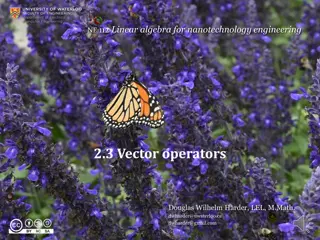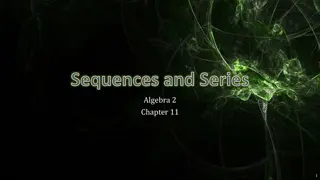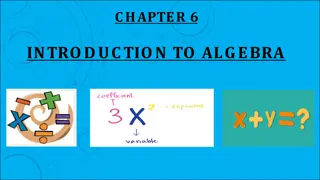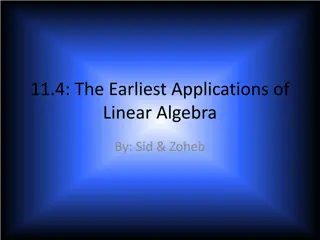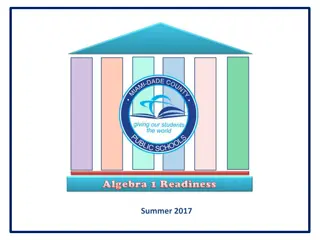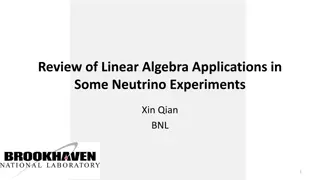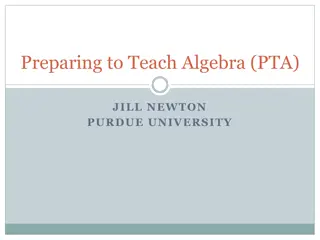
Real Numbers and Algebra Essentials
Delve into the world of mathematics with a focus on real numbers, algebra essentials, and the order of operations. Learn about the properties of real numbers, subsets of numbers, and how to simplify mathematical expressions following the PEMDAS rule. Explore the historical significance of numbers and their role in the development of civilization.
Download Presentation

Please find below an Image/Link to download the presentation.
The content on the website is provided AS IS for your information and personal use only. It may not be sold, licensed, or shared on other websites without obtaining consent from the author. If you encounter any issues during the download, it is possible that the publisher has removed the file from their server.
You are allowed to download the files provided on this website for personal or commercial use, subject to the condition that they are used lawfully. All files are the property of their respective owners.
The content on the website is provided AS IS for your information and personal use only. It may not be sold, licensed, or shared on other websites without obtaining consent from the author.
E N D
Presentation Transcript
Algebra Essentials College Algebra
Mathematics, the Language of Science Earliest use of numbers occurred 100 centuries ago in the Middle East to count items Farmers, cattlemen, and tradesmen used tokens, stones, or markers to signify a single item Made commerce possible and lead to improved communications and spread of civilization Yuan Dynasty iron magic square showing Persian/ Arabic numbers (ca. 1271 1368)
Real Numbers Natural numbers: numbers used for counting: {1,2,3, } Whole numbers: natural numbers plus zero: {0,1,2,3, } Integers: adds negative natural numbers to the set of whole numbers: { , 3, 2, 1,0,1,2,3, } Rational numbers includes fractions written as {? and ? 0} ? |? and ? are integers Irrational numbers is the set of numbers that are not rational, are nonrepeating, and are nonterminating: { | is not a rational number}
Real Numbers There is a subset relationship between the sets of numbers N : the set of natural numbers, W : the set of whole numbers, I : the set of integers, Q : the set of rational numbers, Q : the set of irrational numbers
Order of Operations Operations in mathematical expressions must be evaluated in a systematic order, which can be simplified using the acronym PEMDAS: P(arentheses) E(xponents) M(ultiplication) and D(ivision) A(ddition) and S(ubtraction)
Simplify a Mathematical Expression using the Order of Operations 1. Simplify any expressions within grouping symbols 2. Simplify any expressions containing exponents or radicals 3. Perform any multiplication and division in order, from left to right 4. Perform any addition and subtraction in order, from left to right
Properties of Real Numbers Addition Multiplication Commutative Property Associative Property Distributive Property Identity Property ? + ? = ? + ? ? ? = ? ? ? + ? + ? = ? + ? + ? ? ?? = ?? ? ? ? + ? = ? ? + ? ? There exists a unique real number called the additive identity, 0, such that, for any real number ? ? + 0 = ? Every real number a has an additive inverse, or opposite, denoted ?, such that ? + ? = 0 There exists a unique real number called the multiplicative identity, 1, such that, for any real number ? ? 1 = ? Every nonzero real number ? has a multiplicative inverse, or reciprocal, denoted 1 ? (1 ?) = 1 Inverse Property ?, such that The properties hold for real numbers a, b, and c
Evaluate and Simplify Algebraic Expressions Algebraic expression: collection of constants and variables joined by the algebraic operations of addition, subtraction, multiplication, and division Equation: mathematical statement indicating that two expressions are equal Formula: equation expressing a relationship between constant and variable quantities Simplify algebraic expression to make it easier to evaluate using the properties of real numbers. We can use the same properties in formulas because they contain algebraic expressions.
Desmos Interactive Topic: explore how changing length or width changes the area of a rectangle https://www.desmos.com/calculator/eq1cow0lcj
Rule of Exponents The Product Rule: For any real number ? and natural numbers ? and ?, the product rule of exponents states that ?? ??= ??+?
Rule of Exponents The Quotient Rule: For any real number ? and natural numbers ? > ? the quotient rule of exponents states that ?? ??= ?? ?
Rule of Exponents The Power Rule: For any real number ? and positive integers ? and ?, the power rule of exponents states that (?? ) ?= ?? ?
Zero and Negative Rule of Exponents Zero Exponent Rule: For any nonzero real number ?, the zero exponent rule of exponents states that ?0= 1 Negative Exponent Rule: For any nonzero real number ? and natural number ?, the negative rule of exponents states that ? ? = 1 ??
The Power of a Product Rule of Exponents For any real numbers ? and ? and any integer ?, the power of a product rule of exponents states that (??)?= ????
The Power of a Quotient Rule of Exponents For any real numbers ? and ? and any integer ?, the power of a product rule of exponents states that ?? ?? (? ?)?=
Scientific Notation A number is written in scientific notation if it is written in the form ? 10?, where 1 |?| < 10 and ? is an integer To convert a number in scientific notation to standard notation, simply reverse the process Scientific notation, used with the rules of exponents, makes calculating with large or small numbers much easier than doing so using standard notation
Summary: Exponents and Scientific Notation Rule of Exponents For nonzero real numbers ? and ? and integers ? and ? Product Rule Quotient Rule ?? ?? = ??+? ?? ??= ?? ? (?? ) ?= ?? ? Power Rule Zero Exponent Rule Negative Rule ?0= 1 1 ?? ? ?= Power of a Product Rule Power of a Quotient Rule (? ?)?= ?? ?? ?? ?? (? ?)?=
Square Root The principal square root of ? is the nonnegative number that, when multiplied by itself, equals ?. It is written as a radical expression, with a symbol called a radical over the term called the radicand: ?
Product Rule for Simplifying Square Roots If ? and ? are nonnegative, the square root of the product ?? is equal to the product of the square roots of ? and ? ?? = ? ?
The Quotient Rule for Simplifying Square Roots ? ?is equal to the quotient of the square The square root of the quotient roots of ? and ?, where ? 0 ? ?= ? ?
Operations on Square Roots Radical expression requiring addition or subtraction of square roots: 1. Simplify each radical expression 2. Add or subtract expressions with equal radicands Example: We can rewrite 5 12 as 5 4 3 Using the product rule, this becomes 5 4 3, or 5 2 3 or 10 3 Add the two terms that have the same radicand: 10 3 + 2 3 = 12 3 5 12 + 2 3
Operations on Square Roots Rationalize the denominator of an expression with a single square root radical term in the denominator 1. Multiply the numerator and denominator by the radical in the denominator 2. Simplify Example: 2 3 3 10 Multiply both the numerator and denominator by 10 Simplify: 2 3 10 3 10 10=2 30 30 15 3 10=
Operations on Square Roots Given an expression with a radical exponent, write the expression as a radical 1. Determine the power by looking at the numerator of the exponent 2. Determine the root by looking at the denominator of the exponent 3. Using the base as the radicand, raise the radicand to the power and use the root as the index 5 3 Example: ( 8 38)5= 25= 32
Nth Roots and Rational Exponents Nth Root: If ? is a real number with at least one n th root, then the principal n th root of ?, written as as ? that, when raised to the n th power, equals ?. The index of the radical is ?. ??, is the number with the same sign Rational exponents: another way to express principal n th roots. The general form for converting between a radical expression with a radical symbol and one with a rational exponent is ? ? = ??? ???= ?
Quick Review What is the difference between a natural number and a whole number? What is a rational number? What is exponential notation? What is the order of operations for performing calculations? What is the commutative property of addition? What is the associative property of multiplication? What is the inverse property of multiplication? What is an equation? What is the product rule for exponents? What is the power rule for exponents? What is scientific notation? What is a radical expression? How do you simplify the square root of a product

